Vol 1 No. 32 TROPIC LIGHTNING NEWS October 1, 1966
Index
[The 1966 Vietnam issues of Tropic Lightning News were published in Saigon,
and are of lower quality than later years that were printed in Japan. Over
the years the photographs and text have faded and it has been difficult to
reproduce them. Even when the photos are unclear, I have been included
them to give a sense of the activities in the Division.]
[This issue of Tropic Lightning News was scanned from a bound
library volume provided by the 25th Infantry Division Museum. Several of
the photographs and captions on various pages are missing, or interpreted as
best I could.
The pages were
printed across the center of the 2-page-wide sheet and hidden from sight
because of the way the paper is bound into the book - the book could not be
safely opened wide enough to see that
part of the page.]
Special Color Ceremony to Highlight
25th Division’s 25th Birthday Today
CG Will Present Top Decorations
The 25th Infantry Division is 25 years old today.
To commemorate the occasion a special color Ceremony is scheduled for this
morning on Lightning Loop. Included in the ceremony will be the decoration of
members of the division who have won some of the United States’ top awards.
The presentation was scheduled to be made by Maj. Gen. Fred C. Weyand. Also
planned is the reading of the division history, while a 25-gun salute will be
fired by division artillery. Music for the occasion will be provided by the
Division Band.
In addition to the formal ceremonies, the United Services Organization (USO)
has scheduled to perform two shows at the Lightning Bowl.
The troupe, composed of MC-comedian Joe Jones, vocalist Alvin Robinson, and
the rock’n’roll group, The. Dixie Clip , are to perform at 10:30 a.m. and 2 p.m.
The group was also scheduled to visit the 25th division hospital wards and
the Ilikai East enlisted men’s club. Besides the entertainment special
table-tennis, pool and horseshoe tournaments are scheduled at the Ilikai East.
A Report On Div. In Vietnam
By Sgt. Mike Hirsh
When the 25th Infantry Division was ordered to join the battle against
communism in Vietnam, it was given a multiple mission. Not only were the
“Tropic Lightning” soldiers to battle Viet Cong, they were to battle poverty,
disease and ignorance.
The means used to accomplish this many-faceted job were limited only by the
skill, aggressiveness and ingenuity of the troops, and the results achieved in
the division’s first ten months in Vietnam attest to the excellent training and
versatility of the men.
From the central highlands surrounding Pleiku, where the 3rd Brigade Task
Force is meeting regular North Vietnamese Army (NVA) units, to the lowland
paddies and woods of Hau Nghia Province, where the division’s 1st and 2nd
Brigades are fighting guerrilla forces, the wrath - and generosity - of Tropic
Lightning has become known.
Killed
More than 2500 Viet Cong and NVA soldiers have been killed by units of the
25th. Operations like Wahiawa and Sunset Beach have seen U.S. forces enter the
formidable Boi Loi and Ho Bo Woods, northwest of Cu Chi. Reportedly the
birthplace of the National Liberation Front, the political arm of the Viet Cong,
these areas are no longer guerrilla sanctuaries.
During Operation Wahiawa, the largest “Tropic Lightning” force ever assembled
for one combat mission in Vietnam was thrown at the V.C. Using the combined
resources of both the 2nd and then newly arrived 1st Brigade, plus elements of
division artillery and support command, a forward base camp was established
between the Ho Bo and Boi Loi Woods.
Everything to support the line troops was moved to this forward base.
Engineers went so far as to dig a fresh water well so that resupply helicopters
could make the shortest trips possible under the circumstances. Mess halls were
set up in tents and hot chow was flown to the field troops at least once daily.
Military
Unlike Wahiawa, which was mainly a military action, were Operations Fort
Smith and Santa Fe. Both of these were directed at what has been called “the
other war.” They were battalion-sized pacification missions, used not only to
interdict VC supply lines, but to improve the living conditions of villagers.
The concept was a new one, based on the principle that VC could only go
“underground” for a maximum of five days. Then they would have to expose
themselves to get food, supplies, and new instructions. By moving an entire US
battalion in and
(See Page 11)
196th Registers First Cong Kills
The division’s 196th Light Infantry Brigade “Chargers” began their charge
when the 2nd Bn., 1st Inf., scored the brigade’s first “kills” in a recent
search-and-clear mission three miles west of the brigade’s base camp at Tay
Ninh.
Co. B, commanded by Capt, Joseph Czuberki, was sweeping south when it came
under heavy sniper fire. The company quickly returned the fire, killing one
sniper and wounding another.
The wounded VC managed to l run away to a nearby tunnel.
Giving chase, a member of the brigade’s “tunnel rat” team entered the spider
hole, but returned shortly finding only a blood-stained trail.
While searching for other tunnel systems, the company found a second body
wrapped in a blanket, to confirm the day’s second kill.
A Message From Maj. Gen. Weyand
Officers and Men of the Tropic Lightning Division:
 As we look at the 25th Infantry Division today, its 25th birthday, we do so
with great pride ... pride in being a part of a unit with such a distinguished
record over a quarter of a century and greater, pride in serving with the truly
professional group of officers and men who make up the “Tropic Lightning”
Division today.
As we look at the 25th Infantry Division today, its 25th birthday, we do so
with great pride ... pride in being a part of a unit with such a distinguished
record over a quarter of a century and greater, pride in serving with the truly
professional group of officers and men who make up the “Tropic Lightning”
Division today.
The many fine accomplishments of the Division in World War II and the Korean
War have been recorded and praised by the Army and our nation as a whole. More
than three years ago “Tropic Lightning” soldiers performing as aerial
door gunners here in Vietnam began writing still another chapter in our history.
That chapter is still being written today, on our Silver Anniversary, by each
one of you.
It was shortly after our Organization Day activities last October 1 that our
third call to battle came. The magnificent response you gave to that call
brought Tropic Lightning into swift, effective contact with the enemy and a high
degree of success in a new kind of warfare, counterinsurgency.
Today, as we celebrate our Silver Anniversary ... on the battlefields of
Vietnam, let us remember with a silent prayer and a proud salute the brave and
valiant soldiers of the “Tropic Lightning” who have dedicated their lives in
past years defending freedom with courage and heroism, and most important, with
life itself.
FRED C. WEYAND
Major General, USA
Commanding
Weather to Warm Up – A Little
Higher temperatures and less thunderstorm activity can be expected in October
as the autumn season sets in the Cu Chi and Tay Ninh area.
October marks the transition between the wet and the dry season.
Temperatures during this period at Tay Ninh will increase to an average high of
90 and a low of 75. Cu Chi temperatures will be slightly cooler.
Warm moist air from the southwest will be replaced by the relatively cooler,
drier air of the northeast monsoon.
Southerly winds will prevail during the first part of October. Stronger
surface gusts, however, will occur during the mid-morning and afternoon periods
later in the month.
The season change will cause light fogging in the pre-dawn hours. During
October, fog will increase to three or four days at Cu Chi and one or two days
at Tay Ninh.
In Today’s Issue
| Unit Information | Page 2 |
| World War II | Page 6 |
| Korea | Page 8 |
| Vietnam | Page 10 |
Page 2 TROPIC LIGHTNING NEWS October 1, 1966
|
25th Patch Adopted in 1943
The shoulder patch of the 25th Division was adopted late in 1943. It is
designed in the shape of a taro leaf, red with a gold border, and a bolt of
lightning superimposed in gold.
The taro leaf is reminiscent of the Hawaiian birthplace of the 25th from
elements of the famous old Hawaiian Division, which had originally adopted the
leaf for its patch.
The taro plant has arrow-shaped leaves, often brilliantly colored and is
native to the Pacific Isles, though it is cultivated in many tropical and
sub-tropical areas.
The rootstocks of the taro is a food, the flesh of which is similar to that
of the potato. It is used in the preparation of Poi, formerly a staple food
product of Hawaii.
The slashing, golden zig-zag bolt of lightning symbolizes speed and
aggressive spirit, and was superimposed upon the taro leaf to convey this
additional significance to the shoulder patch.
The division’s nickname, the “Tropic Lightning” Division, is re-echoed by the
bolt of lightning on the shoulder patch. Although the nickname had been carried
by the division, unofficially, since December 1942, it was recognized as the
official title of the division on July 14, 1953.
| BONDS - Command interest in U.S. Savings Bond program is expressed by Gen. W. C. Westmoreland, Commander, U. S. Military Assistance Command, Vietnam. |
 |
General Weyand Leads 25th Since Aug. 1964
Maj. Gen. Fred C. Weyand was born in Arbuckle, Calif., Sept. 15, 1916. His
military career began May 6, 1938, when he was commissioned a second lieutenant
in the Reserve Officers Training Corps prior to his graduation from the
University of California.
He was called to active duty on December 19, 1940, at the Presidio of San
Francisco with the 6th Coast Artillery Regiment.
In 1943, he was assigned to the War Department for special schooling and then
overseas for intelligence work in Burma and India with Gen. Joe Stilwell’s
headquarters. In March 1945, Gen. Weyand was assigned to Headquarters, China
Theater, in Chung King, where he served in an intelligence capacity until the
end of the war.
After World War II, Gen. Weyand returned to the War Department as head of the
Military Branch of the Army’s Intelligence Service.
In August 1946, he was assigned to Headquarters, U.S. Army, Pacific, in
Hawaii as the command G-2.
Ile also served as a member of Joint Task Force 7, which was responsible for
conducting the atomic weapons tests at Eniwetok in 1948; and as a member of the
Joint Staff of the Commander-in-Chief, Pacific.
In 1950, after attending the Advanced Infantry School, he served as executive
officer of the 30th Inf. Regt. 3rd Division, at Ft. Benning, Ga. He served with
the 3rd Division in Japan and Korea in 1950 and 1951, successively as deputy
chief staff; as commanding officer of the 1st Bn., 7th Inf. Regt., through five
battle Campaigns; and finally as division operations officer.
In January 1952, Gen. Weyand headed an instructor group teaching regimental
tactics at the Infantry School. In 1954, he was assigned to the staff of the
Secretary of the Army.
From 1958 to 1960, Gen. Weyand was assigned to Berlin, where he commanded the
3rd Battle Group, 6th Infantry, for a year and a half, followed by duty as
assistant to the US Commander, Berlin.
His next assignment as chief of staff, Headquarters, US Army, Europe,
Communications Zone, in Orleans, France was followed by orders to Washington,
D.C., in 1961 for duty in Legislative liaison.
He served in this activity, dealing with congressional affairs, for three
years. On August 22, 1964, Gen. Weyand assumed command of the 25th Infantry
Division at Schofield Barracks, Oahu, Hawaii.
Page 3 TROPIC LIGHTNING NEWS October 1, 1966
Brigade Receives U.S., Viet Flags
The 196th Light Infantry Brigade, attached to the 25th Inf. Div., held first
anniversary ceremonies at Tay Ninh on September 15.
Attending the ceremonies were Maj. Gen. Fred C. Weyand, division commander,
Brig. Gen. Edward H. deSaussure, brigade commander, and Ho Duc Trung, province
chief for Tay Ninh province.
Highlight of the colorful ceremony was the presentation of flags to the
Brigade. Gen. Weyand presented an American flag and Mr. Ho gave a Vietnamese
flag. Both were raised marking the first time the American flag has flown over
the Tay Ninh base camp of the 196th Brigade.
Gen. deSaussure spoke briefly of the brigade’s history, noting that the men
had come from a newly formed, untrained unit to a fully trained organization
already involved in combat in the very brief span of one year.
“As the Brigade takes its place in South Vietnam to combat communist
aggression,” the general said, “it is fitting that the United States flag be
raised beside the flag of the Republic of Vietnam.”
Mr. Ho, the province chief also spoke briefly. He said, “In this atmosphere
of mutual understanding and in front of these brave American comrades, we have a
feeling that the 196th Brigade is a true model of the U.S. Armed Forces with its
brave tradition and invincible power.”
“We have strong belief that the 196th Brigade has all the capabilities and
conditions to defeat the communists. We expect to come back here next year to
celebrate the second anniversary of the brigade.”
The 196th Light Infantry Brigade - called the “Chargers” - was formed a year
ago at Fort Devens, Mass., under the command of the present deputy commander,
Col. Francis P. Conaty.
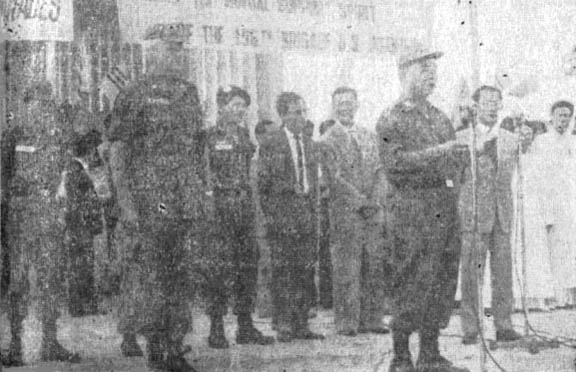 |
| GREETS - Brig. Gem Edwartd H. deSassure Jr. and top American and Vietnamese leaders listen to a Vietnamese officer extend greetings on behalf of the people of Tay Ninh to 196th Light Infantry Brigade. (Photo by Sp4 James Pardue) |
Little Bears And Polar Bears Run Loose Around Tay Ninh
By Sp4 Todd Darch
The “Little Bears” and the “Polar Bears” got together the other day, but it
wasn’t at The Bronx Zoo. The two joined forces to do battle against the Viet Cong in
the rice paddies and jungles of South Vietnam.
The Little Bears, helicopters of Co. A, 25th Avn. Bn., left their “bear pit”
at Cu Chi and flew to Tay Ninh to pick up the Polar Bears of the 4th Bn., 31st
Inf., 196th Light Infantry Brigade. The Little Bears mission for the day was to
transport the Polar Bears a few miles south of their base camp for a search and
destroy operation.
Shortly after sunrise, the Little Bears set down at Tay Ninh helipad to pick
up their comrades. With the eagerness of professional soldiers, the Polar Bears
jumped on the UH-IDs and were soon airborne. The Little Bears carried the
infantrymen to their destination in a matter of minutes.
It was now the job of the “flying bears” to support the “ground bears” with
firepower from the air and needed supplies. As the infantrymen pushed through
the dense jungle, a chopper with the Little Bear proudly painted on its nose was
often seen circling overhead.
As the day neared an end, the Polar Bears settled down for the night at a
predetermined checkpoint. There they found C-rations waiting for them. The
food had been dropped by their friends from above, who just naturally knew that
after a long day, they would be hungry as a bear.
|
25th Radio Special
|
‘Hornets’ Invade Base Today
A swarm of hornets will invade Cu Chi today as the 116th Air Assault company
“Hornets” move into their new quarters at the Tropic Lightning base camp.
Previously stationed at Phu Loi, the 116th has been flying in support of the
25th Infantry Division for many months.
The 400-man plus company is now expected to respond faster to 25th
requirements.
The Hornets are commanded by Maj. James H. Patterson, 35, of Lexington,
Mass. He heads a task force composed of the air assault company and three
attached units, the 392nd Trans. Co., the 431st Med. Det. and the 283 Sig. Det.
Aircraft maintenance experts in the 392nd keep the 116th’s “Hueys” flying
while the flight surgeons and medics of the 431st look after the crew.
2/14th ‘Battle Dragon’ Gets Purple Heart
The 2nd Bn., 14th Inf., “Battle Dragon” was recently awarded the Purple Heart
for wounds sustained during the VC’s sneak mortar attack on Cu Chi.
Ever since the battalion arrived, the Dragon had rested atop a bunker in
front of the battalion area. During the attack, one round landed in the road
close to the large crest. Several pieces of flying metal tore gaping wounds in
the Dragon’s mouth and face.
As a result, the unit saw fit to award its valiant crest the Purple Heart at
a recent ceremony. Presently, the Dragon is interned at the battalion’s
maintenance shop, where it will remain until total restoration is achieved.
After the Battle Dragon’s restoration, it will again resume its position high
on the command banker.
Grand Old Man of 25th Division
CWO James Y. Blevins, chief, military pay branch, personnel services division
of the 25th Inf. Div. wears the “Tropic Lightning” patch on both his right and
left shoulders.
The patch on his right shoulder isn’t there just for looks, he earned his
right to wear it in Korea.
He joined the 25th Inf. Div. at Osaka, Japan, as the division operations
sergeant in the G-3 section (operations and training) in 1948. Later that year
he made warrant officer. While the division was ordered to Korea in July 1950.
Mr. Blevins served as officer in charge of AG (Adjutant General) forward and was
given a field commission.
While in Korea, he was in the first five campaigns the division fought: the
UN Offensive; the Chinese Communist Forces Intervention; Chinese Communist
Forces Spring Offensive, and the First UN Counteroffensive.
He was awarded the Bronze Star for his work as the AG forward
officer-in-charge.
“The most memorable event in Korea to me, was our breakthrough of the Pusan
Perimeter in September 1950,” Chief Blevins said.
“The division headquarters moved from Masan to North Korea.”
“All along the way, we could see thousands of refugees. The sight of them
hungry and walking to the south was something I’ll never forget,” the warrant
officer described. “One can’t help feeling compassion far all those people,
especially the children.”
He was transferred in July 1951, after serving a year in combat, to the U.S.
Army Pacific headquarters at Fort Shafter, Hawaii.
This was not the only other time the chief warrant officer served with the
25th Division.
Chief Blevins was at Schofield Barracks back in 1940, as a member of the “Old
Hawaiian Division,” and when the 24th and 25th Divisions were formed, he was
assigned to the 298th Infantry which was originally attached to the 24th
Division.
When the 24th was deployed, the 298th was attached to the “Tropic Lightning”
Division.
The 298th stayed at Schofield when the 25th Division moved out for
Guadalcanal and later went on to fight in the South Pacific as a Regimental
Combat Team.
In 1963, he was assigned to the 125th Signal Battalion, and was further
assigned to the Division AG.
He was again assigned to the “Tropic Lightning” Division AG in may 1965, by
requesting an intra-theatre transfer after serving 16 more months in Korea.
And now in Vietnam, Mr. Blevins performs the same job for the 25th. He just
goes on and on.
Page 4 TROPIC LIGHTNING NEWS October 1, 1966
Decorated
| SILVER STAR MEDAL (POSTHUMOUSLY) | |
| Capt. John A. Renner, Co. A, 1st Bn. (Mech), 5th Inf. | Sp4 John J. Monette, Co. A, 25th Avn. Bn. |
| BRONZE STAR MEDAL (VALOR) |
|
|
Capt. David P. Williams, Co. B, 2nd Bn., 14th Inf. PSgt. Bernard A. Green, Co. A, 1st Bn., 27th Inf. (Posthumously) Sgt. Donald H. Coleman, Co. A, 4th Bn., 23rd Inf. Sgt. Jerry G. Masters, Co. A, 1st Bn., 27th Inf. Sgt. Jackie A. Powell, Co. C, 1st Bn. (Mech), 5th Inf. Sp4 John D. Beltz, Co. A, 1st Bn., 27th Inf. Sp4 George E. Foley III, Co. A, 1st Bn., 27th Inf. |
Sp4 Michael N. Northcutt, Co. C, 1st Bn. (Mech), 5th Inf. Sp4 Dana Riley, Co. C, 1st Bn. (Mech), 5th Inf. PFC Jerry Blevins, Co. A, 1st Bn., 27th Inf. PFC William Cobb, Co. A, 1st Bn., 27th Inf. PFC John Doike, Co. A, 1st Bn., 27th Inf. (Posthumously) PFC Charles R. Fleming, Co. A, 1st Bn., 27th Inf. (Posthumously) PFC Richard L. Hadd, Co. A, 2nd Bn, 27th Inf. |
| AIR MEDAL (VALOR) |
|
|
Maj. Raymond F. Huntington, Co. B, 25th Avn. Bn. Capt. Terry P. Mix, Co. B, 25th Avn. Bn. Sp5 Jonah S. Esque, Co. B, 25th Avn. Bn. |
Sp5 Thomas F. Lancer Co. A, 25th Avn. Bn. Sp4 James M. Jones, HHB, 25th Div. Arty. |
| PURPLE HEART |
|
|
2nd Lt. Roland D. Douglas, Co. C, 1st Bn. (Mech), 5th Inf. Sgt. Leroy A. Factora, D Tip., 3rd Sqdn., 4th Cav. Sgt. George R. Reynolds, B Trp., 3rd Sgdn., 4th Cav. Sp5 Luis F. Ramos-Deliz, HHC. 1st Bn. (Mech), 5th Inf. Sp4 William A. Cooper, Co. C, 4th Bn., 23rd Inf. Sp4 Steven A. Jedloski, Co. C, 1st Bn., (Mech) 5th Inf. Sp4 Albert Williams Jr., Co. C, .2nd Bn., 27th. PFC Kenneth M. Chapman, HHC, 4th Bn., 23rd Inf. |
PFC Amadeo R. Lara Jr., D Trp., 3rd Sqdn., 4th Cav. PFC Charlie McBride, Co. C, 2nd Bn., 14th Inf. PFC Maxie Patterson, Co. A, 1st Bn., 27th Inf. PFC Ralph A. Phillips, Co. C, 1st Bn., 27th Inf. PFC Dauche M. Presley, Co. A, 1st Bn., 27th Inf. PFC Wolfgang P. Rieger, Co. A, 4th Bn., 23rd Inf. PFC Vincent S. Robbins, Co. C, 2nd Bn., 27th Inf. PFC Vincent Simonelli, Co. A, 1st Bn., (Mech), 5th Inf. |
DOD’s New Policy to Curb Troop Piaster Spending in VN
Defense Department has announced a comprehensive plan to reduce DOD piaster
spending in Vietnam as part of a FY 67 government-wide program to lessen the
impact of the military buildup there on the local economy.
In testimony before a House Foreign Operations and Government Information
Sub-committee in mid-August DOD projected a 53 per cent reduction of piaster
spending by individual servicemen.
Enlarging the range of PX products and services will be one of the means to
reduce piaster spending by individuals.
A four-fold increase in the “Out-of-Country Rest and Recuperation Program” to
provide in FY 67 at least 250,000 individual trips is also addressed to
diverting personal funds that would otherwise flow into the Vietnamese economy.
DOD also anticipates that personnel will spend fewer piasters when they begin
to take advantage of the new Uniformed Service Deposits program that pays a 10
per cent interest rate on overseas deposits.
The plan also calls for these actions:
Relocating military personnel and civilian employees in private housing to
reduce or eliminate piaster rental expenditures.
Deployment of military personnel to up-country locations away from the urban
areas and their market places.
The DOD report said that burgeoning demand generated by a rapid influx of U.
S, personnel and facilities must not be allowed to outstrip the Vietnamese
resources.
Lieutenant To Captain In One Year
The Army has announced a new promotion policy that will see several thousand
first lieutenants promoted to captain before the end of the year.
Under the plan certain commanders have the authority to promote first
lieutenants in the professional services to captain on October 31. This
includes those eligible in the Judge Advocate General’s Corps, Chaplains,
Veterinary Corps and Medical Service Corps officers with PhDs allied to
medicine. Medical and Dental Corps officers are covered under another plan.
Furthermore, all such officers who come on active duty after November 1 will
begin service as captains.
Also effective November 1 is authority to promote to captain all eligible
first lieutenants not mentioned above who qualify according to a new schedule of
time-in-grade.
As of April 2, 1968 time-in-grade promotions to captain is set at 18 months
for those promoted to first lieutenant on and after November 1 1966.
The Army said that in granting this authority it recognized that commanders
are in the best position to determine promotions.
But it also cautioned commanders that promotion to captain is a more
significant advance than promotion from second to first lieutenant and that they
should not consider this as authority for automatic promotion.
The message announcing the new policy, DA Message 780697 of September 2, said
current recommended promotion lists and the one established in July will be
exhausted by October 31.
Editorial
Wear the Gold Bar
The uncommon young man wears the gold bar of an Army second lieutenant. His
rank represents proven abilities, keyed to the critical demands of the modern
Army.
His presence in the military implies a decision that sets him apart from the
majority of his contemporaries in civilian life.
The decision to wear the gold bar, is, of course a personal one. But there
are a number of convictions shared by most young officers.
There is usually a common denominator of personal pride and patriotic spirit
in selecting the military service.
There are also some very practical considerations. Weighing heavily on the
decision, they ask, “What’s in it for me?”
In today’s competitive world, the Army has frank answers for that straight
forward question. It wants the young officer and it offers him a variety of
sound reasons for joining the service and staying with it.
A million-man Army is a complex organization with countless jobs contributing
to the performance of its mission. Advanced degrees and sophisticated technical
skills are now as much a part of the Army as rifles and combat boots. Perhaps
the greatest incentives represented by the gold bar are the traditional ones -
the time honored privileges of the officer’s corps. Good pay and allowances,
medical care, travel, social life, and the refreshing pace of new assignments
are benefits that few young men can afford to overlook.
Without waiting for his age to slowly open the doors to leadership, the young
officer is quickly given command position. Though he has ample support he is on
his own. His men and their performance depend on his abilities.
It’s not long before the gold bar is replaced by one of silver, and the young
officer is on his way.
He has launched a career that demands a great deal of a man. It requires
commitment and sacrifice as well as a large measure of real ability.
The rewards, however, are equally full. For a young man that measures up -
the uncommon young man - the decision to wear a gold bar is a wise one.
(ANF)
|
Appreciation HONOR – Maj. Masano Miyagishima, commander of the 25th Mil. Intel. Del. receives an appreciation plaque from Maj. Gen. Fred C. Weyand, division commander. |
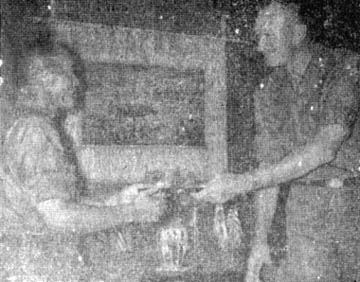 |
| The TROPIC LIGHTNING NEWS is an
authorized publication of the 25th Infantry Division. It is published
weekly for all division units in the Republic of Vietnam by the
Information Office, 25th Infantry Division, APO U.S. Forces 96225. Army
News Features, Army Photo Features and Armed Forces Press Service material
are used. Views and opinions expressed are not necessarily those of the
Department of the Army. Printed in Saigon, Vietnam, by Saigon Daily
News. Maj. Gen. Fred C. Weyand . . . . Commanding General Maj. William C. Shepard . . . . . . Information Officer 1st Lt. William H. Seely III . . . . Officer-in-Charge Sp4 David L. Kleinberg . . . . . . . Editor Sp4 Adrian E. Wecer . . . . . . . . Editorial Assistant |
Page 5 TROPIC LIGHTNING NEWS October 1, 1966
Artillery NCO Gets Top Medal
Sgt. Robert L. Edwards, of Btry. B, 2nd Bn., 13th Arty., received the Silver
Star in a ceremony recently at Tay Ninh, home of the 25th’s 196th Light Infantry
Brigade.
Sgt. Edwards was presented the nation’s third highest award by Col. Thomas H.
Sayes, 23rd Artillery Group commander, for gallantry in action while serving as
forward observer during a search-and-clear mission in Tay Ninh province, 65
miles northeast of Saigon.
As the company maneuvered through dense jungle it came under intense fire
from an estimated three VC companies. During the encounter Sgt. Edwards
skillfully called in artillery fire, preventing the company from being overrun.
As the intensity of the fire fight increased Sgt. Edwards continued to adjust
barrages on the charging Viet Cong.
When the VC closed in on the rear of the company, he moved to the highest
available terrain and directed fire within 50 yards of his own position to clear
a withdrawal route.
As his outnumbered company withdrew, he remained with the last elements and
continued to direct suppressive fire on the advancing VC.
When his radio operator was seriously wounded, Sgt. Edwards called in a
helicopter and assisted the wounded man into the aircraft.
| TOP AUSSIE - Maj. Gen. Fred C. Weyand, division commander, and Maj. Gen. K. MacKay, commanding general of Australian forces in Vietnam, walk from a briefing at 25th Div. Arty. headquarters. Gen. MacKay visited the Cu Chi base camp recently to tour the division area. (Photo by SFC Joe Hawkins) |
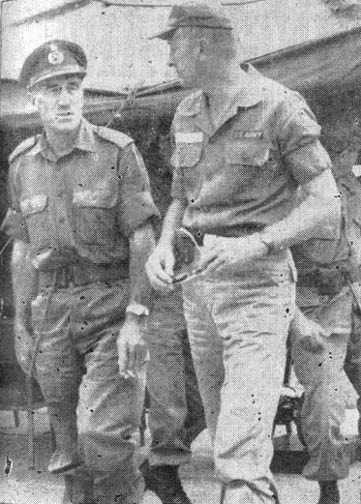 |
|
Battlefield Chaplain
|
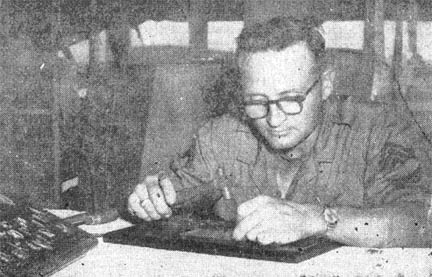 |
ALL TRADES - SFC Ralph L. Montigny, 34, of Lawton, Okla., prepares a special presentation plaque in his shop at division headquarters. In his job as division maintenance NCO Sgt. Montigny prepares many such plaques. (Photo by PFC Ron Nelson) |
NCO Has Many, Many Trades
“Jack of all trades” is about the closest civilian term you can find for SFC
Ralph L. Montigny of HHC, 25th Infantry Division.
Sgt Montigny’s official title is Division Maintenance NCO. He must be
carpenter, plumber, electrician, refrigeration specialist and mason to perform
his daily duties.
As if these tasks were not enough, Sgt. Montigny has taken on still another
job. He has taught himself the art of making plaques for special occasions in
the division.
The majority of these plaques are given to members of the general special
staff when they depart from the division for reassignment.
These mementos of service with the division are fashioned from Cambodian
teakwood and bear the crests of all the division’s units.
The officer’s name and time with the division are engraved on a brass plate,
which is flanked by the taro leaf patch. Since the division was deployed to
Vietnam last January, 37 of the plaques have been presented to departing
officers.
The 34-year-old Montigny is a resident of Lawton, Okla. Before joining the
25th he was stationed with Co. D, 7th Bn., 3rd Tng. Regt. at Fort Gordon, Ga.
PFC’s Hard Work Finally Pays Off
PFC Richard Salazar, of Co. B, 1st Bn., 27th. Inf., “Wolfhounds” has been on
numerous missions with his unit while he’s been in Vietnam. Recently, his days
of walking and sweating paid off.
Co. B left the division’s base camp by helicopter to sweep an area one mile
west of Trang Bang, some 30 miles northwest of Saigon.
As they approached the landing zone, the pilots spotted three V.C. running
into a woodline. Once on the ground, the Wolfhounds gave chase.
“We searched the woodline, but they weren’t there,” said the 21-year-old
automatic rifleman from Raymondsville, Tex. “Thinking they might be in a paddy
breathing through reeds, we pounded the area with M-79 rounds in hopes they’d
jump from the concussion and give themselves away.”
“After about 10 minutes, nothing happened so the company pulled out of the
area and left my squad behind.”
“We set up a hasty ambush and soon two of them showed up,” he said.
“We wanted to capture them alive, but they were too far away to chase so I
opened up with my M-14, killing one of them. The other didn’t give us too much
trouble after that.”
Searching the area further for the third one, the Wolfhounds decided they’d
be going home with a two-out-of-three score for the day.
“It was a good day though,” added PFC Salazar, “when we go out there and
either kill or capture VC without taking casualties, it’s a real morale
booster”.
Col. Turner Leads 2/13th
Lt. Col. Albert F. Turner has assumed command of the 2nd. Bn., 13th Arty.,
23rd Artillery Group, at Tay Ninh.
Lt. Col. G.E. Robinson, former commander, presented the battalion colors to
Col. Thomas H. Sayes, 23rd Group commander, who in turn presented the colors to
Col. Turner.
Among the guests were Brig. Gen. Willis Crittenberger, II Field Force,
Vietnam, artillery commander; Brig. Gen. Edward H. deSaussure Jr., 196th brigade
commander; Col. Daniel B. Williams, 25th Div. Arty., commander, and Lt. Col.
William C. Schwartz, 3/82nd Artillery commander.
Procurement
Defense supply agency procurement nearly doubled in FY66, increasing to $5.7
billion from $3 billion in FY65. DSA, which furnishes commonly used supplies
such as food, clothing and POL to all military services, attributes rise to
impact of Southeast Asia military buildup.
Page 6 TROPIC LIGHTNING NEWS October 1, 1966
WW II: OFF TO LIGHTNING START...
The 25th Infantry Division, born quietly on Oct. 1, 1941 from disbanded
Hawaiian Division units, found itself defending beach positions near Schofield
Barracks, Hawaii, only two months later after the surprise Japanese attack on
Pearl Harbor.
Commanded by Maj. Gen. Maxwell Murray, the 25th division found island defense
to be only a prelude to a long, hard-fought war which would take the division
far into the jungles of the Japanese-held Pacific Islands.
After defending naval installations at Oahu for six months and spending
another half year in jungle training, the 25th was ready to move into the
offensive.
Now under the command of Maj. Gen. J. Lawton Collins, all units had landed at
Guadalcanal by Jan. 4, 1943, ready to begin the United States’ long march back
to the Philippines.
Guadalcanal was their first step; their first confrontation with the enemy.
Little was known of the Japanese to be encountered except that they held the
western part of Mount Austen in force and that two nearby enemy hills seemed to
be well organized. At 5 a.m. on Jan. 10, 25th artillery began softening up the
area before the doughboys jumped off on their first operation.
Bottled
By Jan. 15, the Japanese had been bottled-up into three main pockets, and by
the Feb. 5, division units had joined and ended the Japanese occupation of the
island. The swiftness of the 25th during this campaign was so devastating that
the division was from then on called the “Tropic Lightning” Division.
After the campaign, the division garrisoned the island for the next five
months. The casualties had not been high, but sickness had taken a large toll
of the men. The jungle heat was terrifying, and sanitation conditions were
poor. Supplies were few and the troops were continuously losing weight as
nightly air raids interrupted much needed rest.
By July of the same year the 25th was ready to continue the fight.
Landed
On July 21, the 161st Infantry Regiment of the division landed at New Georgia
in the fight for the all-important Munda Airfield, a source of constant torment
to U.S. forces. Other Army and Marine units had failed to make progress on this
vital installation.
The lone 25th regiment began their push immediately by securing all the high
ground surrounding the field. In one massive attack in early August, it took
the field.
The 27th Infantry Regiment arrived to aid the 161st complete the fight.
Forty days later the two 25th units had pushed the stubborn Japanese into the
sea.
Sailed
The first 25th elements for New Zealand sailed in November 1943, followed
shortly by the remaining units.
For three months the division rested and had a taste of civilized life while
it continued to train. Gen. Collins left for a new assignment and Brig. Gen.
Charles L. Mullins of Los Olivas, Calif., took command.
In February 1944, the division landed on New Caledonia and
bivouacked 70 miles
north of Noumea. This was home for the next 10 months, and replacements were
brought in and trained. Training was for a different kind of fighting, for
rather than jungle, the division was to meet the enemy in the open. In October,
the 25th was ordered into the Luzon campaign in the Philippines.
Action
The 25th was committed to action on Jan. 17, 1945, assigned to plug the gap
between the 6th and 43rd divisions. Elements of the 161st regiment entered the
town of Binalonan, cutting a major highway, on the evening of Jan. 19.
They were immediately counter-attacked from the rear by enemy tanks hidden in
shell-torn buildings and dug-outs. But the division held its ground and by
morning had knocked out 13 enemy tanks and were in the process of clearing out
the last snipers.
The first big capture of enemy supplies also came that morning with the
discovery of an ammunition dump and over 10,000 artillery shells.
(See Page 7)
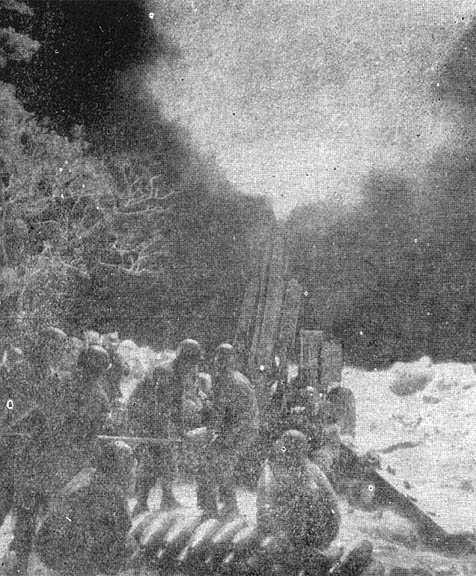 |
BARRAGE - Veteran artillerymen of Btry. C, 90th Field Artillery, lay down a murderous barrage on troublesome Japanese artillery positions. |
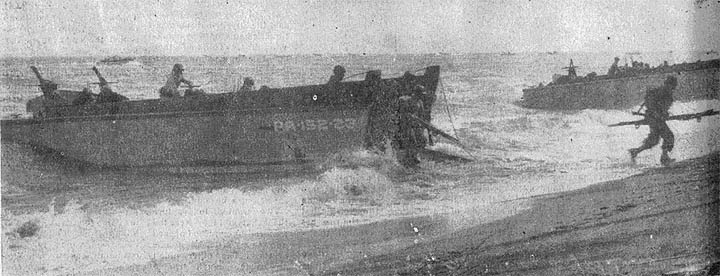 |
|
AID - A stretcher and aid party land from an LCVP during division’s landing on Guadalcanal. |
Page 7 TROPIC LIGHTNING NEWS October 1, 1966
(From page 6)
Following the capture of Binalonan, the 161st and 27th Regiments were ordered
to Asingan. The 35th, commanded by Col. Stanley R. Larsen, now I Field Force
Vietnam commanding general, was held in reserve.
Fierce
The battle for San Manuel was especially fierce because the enemy had dug in
their tanks and were determined to resist the attack.
After five days of intensive fighting, San Manuel fell. The night before the
battle was over the Japanese made a banzai attack with infantry supporting
tanks, but the 161st lines held. The box score for the San Manuel fighting
read: 50 enemy tanks destroyed and 1000 Japanese killed.
Swinging southward, the 27th Regiment was advancing on the town of Umingan.
The night of January 28, a Japanese artillery column was immediately called in
on the road.
The enemy column was then caught between two 27th road blocks and was
destroyed by infantry weapons. A total bag of eight tanks, eight artillery
pieces, 15 trucks and 75 Japanese dead was counted the next morning.
Committed
Meanwhile, the 35th Regiment had been committed to action and was driving on
the town of Lupao. The enemy defenses were similar to those at San Manuel, and
again it was infantry assault weapons versus enemy armor. The battle lasted
four days, with 40 tanks knocked out and 1200 Japanese killed. In all, two
complete regiments of Japanese tanks were destroyed in the Luzon fighting.
Six men of the division were awarded the Medal of Honor for heroism during
the pacific Campaigns.
Following the cease fire, the “Tropic Lightning” division was ordered to
Japan, to serve as an occupying force. It was not until 1950 that men of the 25th were
ordered out of Japan and into combat in. Korea.
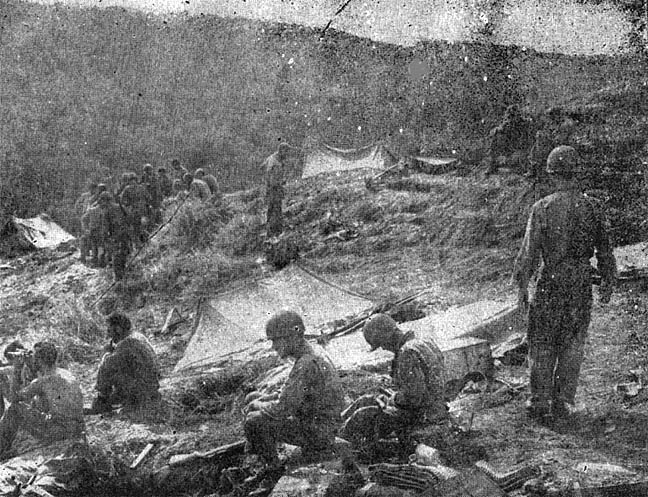 |
|
CAMP - Encamped on the front lines, hill 44, 25th Div. 35th Inf. at Guadalcanal takes a rest. |
| FIRE - Unidentified soldier of the 25th division fires into Japanese-held cave after throwing a fragmentation grenade. |
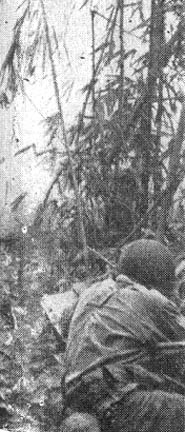 |
 |
| FLOAT - Floating weapons’ carrier across river under its own power, the crossing was effected on four pontoons made from canvas covers and filled with trees, twigs and grass. The front wheels act as rudders and the rear wheels as power. |
Page 8 TROPIC LIGHTNING NEWS October 1, 1966
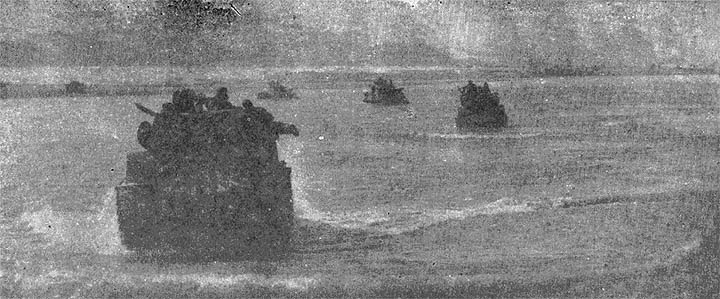 |
| CROSS - Tanks of Co. C, 89th Tank Battalion, cross the Han River, Korea, during action against the Chinese Communists in the area. |
Korea: 25th Meets Red Threat...
North Korea’s surprise attack on the Republic of Korea immediately implicated
the 25th division.
On Independence Day, 1950, the 25th replaced the 24th division on Honshu and
Kyushu Islands as the occupation force. The following day, the division was
alerted to move to Pusan, Korea, to halt the aggression. The 27th Infantry
“Wolfhounds” were the first to leave, and went by train to ports where United
Nations ships carried them to Pusan.
Maj. Gen. William B. Kean, division commander, flew to Pusan on July 8, and
by the 18th, the rest of the division was in Korea. Their first task was to
relieve units of the 24th division operating from Taegu northeast to Vechon.
Included was the task of defending the airfield at Yonil and the port of Pohang
Dong. This responsibility fell to the second of the 27th.
The rest of the 27th went to Andong and above to act as a blocking force.
The 24th division went to Kumchon for the same purpose. The 35th camped near
Pohang Dong and Kyong-ju.
Action
On July 20, the division assembled astride the Hamchang-Sangju-Kumchon road
relieving the Korean 1st and 2nd divisions. Seven Battalions defended a
27-mile-wide zone of extremely rugged terrain.
On August 2 the 25th was called to make what was later called a
history-making maneuver: the entire division moved 150 miles to the south in a
matter of hours to block a rapidly advancing and virtually unopposed enemy force
dashing for Pusan. This move ultimately saved Pusan from certain occupation.
General Kean, commanding all UN troops in the area, was ordered to attack
over 10,000 enemy troops near Chinju at dawn on the seventh of August. This was
the first offensive action in the Korean campaign.
Success
The North Koreans were apparently ready to attack, and the 25th’s attack
caught them off balance; even so, they offered stiff resistance and heavy
casualties were inflicted. The final offensive was made on August 12 and the
objective was taken, the Reds repulsed and the city of Masan saved. ROK
President Syngman Rhee later cited the 25th for outstanding and heroic
performance of duty on the field of battle during the first days of August
1950. The division was also awarded the ROK President Unit Citation for this
action.
Hard won as the ground was, the 25th was ordered to fall back to a defensive
position to allow other units to meet a new and stronger threat in other areas.
The command chose a mountainous area to defend the southern Pusan Perimeter.
This defense cost the division many men, and the North Koreans were getting
replacements quicker than the 25th was. The enemy was building up for an
offensive to capture the UN supply base at Pusan.
Midnight, August 31 signaled the beginning of the enemy offensive. A
massive artillery barrage hit all division positions simultaneously, followed by
a vicious human-wave assault on the line. The North Koreans finally crashed
through at a point defended by untrained South Koreans.
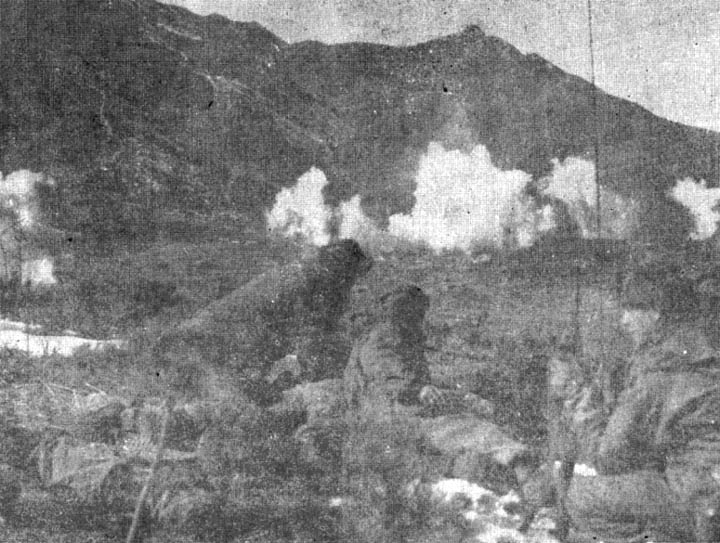 |
| ATTACK - An artillery officer directs UN troops as they drop white phosphorous on a Communist-held post in the background, while elements of Co, A and Co. K, 35th Inf. Regt., keep a sharp lookout for for any movement of the Communist forces. |
Page 9 TROPIC LIGHTNING NEWS October 1, 1966
...With Power, Determination – And Victory
| Maj. Logan E. Weaton of Frank, Pa., S-3 officer ... rushes up hill as UN troops land from Task Force “Punch” against the Chinese Communists near Seoul, Korea. Maj. Weston is known as the “fighting parson.” |
 |
 |
| PROUD - SFC William C. Posey, Honolulu, leads a “captured” cow with ammunition for front line duty during the battle of Waegwan in South Korea. As platoon Sergeant with Co. I, 5th Regt., Sgt. Posey was decorated with the purple heart and silver star medals for leading a bayonet attack on enemy held positions. |
[A portion of the story is missing in the fold of the page.]
...of Manchuria across the Yalu, forcing UN troops back along their 50-mile
front. The situation was grave but not disastrous.
The Chicoms lost many men, but captured the positions they sought. The 25th
was ordered into defensive positions along the Changchon river on November 30,
but more Chicom reinforcements streamed across the Yalu, forcing the UN troops
further south. The 25th acted as a blocking force while the other withdrew.
By September 14, a strong defensive position was established along the Imjin
River and heavy defensive preparations were made.
Throughout the remainder of 1951, the division took in a number of operations
destined both to mop up pockets of resistance behind the lines and to push the
front forward. Ripper, Rugged, Dauntless, Piled River and others were the
operational code names that will never be forgotten by those who took part.
The Chicoms were now above the 38th parallel and missions were held to
harassment raids and intelligence gathering forays to ameliorate conditions for
a truce; However, the division made certain that they remained highly prepared
for combat by instituting a continual series of combat training programs. As
outgoing IX Corp commander, General Jenkins, said, “Today the 25th Division is
like a razor’s edge.”
Seoul
On May 5, 1953, the division was assigned the responsibility of guarding the
approaches to Seoul in the vicinity of Musan-Ni and Chang-Dan. But the war was
not yet over. The last three days of May marked the most vicious fighting the
division had seen in over a year. The Chicoms hurled the better part of a
division at one flank of the Tropic Lightning Division, but the previous months
of training paid off and the UN lines held.
In July the division was relieved of front line duty and moved to camp Casey,
beginning another training program to keep ready for recommitment.
The 25th relieved the 7th Infantry Division in the Imjin-Gang Valley in the
middle of August and started clearing out the Demilitarized Zone.
Hawaii
By August 20, 1954, the division was notified of its imminent move to
Hawaii. Advance parties arrived on Oahu on September 2, 1954, and the rest of
the division finished the trip by October 17.
More than 1000 men were decorated for gallantry and valor while serving with
the 25th in Korea. Fourteen Medals of Honor, 74 Distinguished Service Crosses
and more than 900 Silver Stars made the 25th not only among the most decorated
but the most proud of its initial and continued response to the communist
threat in the Republic of Korea.
 |
| Men of Co. E, 2nd Bn., 35th Regt., supported by tanks, move north above Suwon to make contact with the Chinese Communists. |
Page 10 TROPIC LIGHTNING NEWS October 1, 1966
Vietnam: Just A Plane Hop Away...
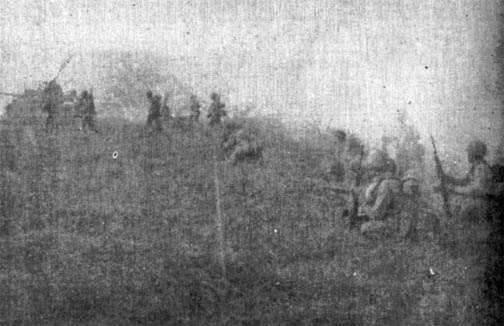 |
| EXERCISES - Elements of the 1st Brigade advance through a smoke screen laid down by the aggressors as they retreated during exercise “West Wind,” a brigade size, joint services amphibious landing exercise and a counterinsurgency anti-guerrilla operation on the Island of Molokai, Hawaii. |
Home From War, 25th Readies
In August 1954, when word reached the 25th Infantry Division in Korea that
it was to return to Hawaii, it was met with jubilation by all its men. For 12
long years the division had been away from Hawaii, six of them in combat. In
Korea, the division had seen more than 800 days of fighting, and now it was
going home.
On Sept. 21, 1954, the 25th Infantry Division troops arrived in Honolulu
aboard the troop ship USNS General Gordon. Bands, hula girls, and 25,000
orchids dropped from helicopters, attested to the admiration of Hawaii for its
famous division.
The following years became years of preparation for the division’s mission as
the Army’s reserve force in the Pacific. Their readiness was put to the test in
1962 when a task force was sent to Thailand to protect its troubled frontiers
from communist harassment.
During that period, the 25th acquired the reputation of being the only
counter-guerrilla trained division in the Army, establishing extensive schools
in the technique of jungle warfare, the teaching of five Asian languages and in
training against the possibility of enemy capture at its unique Code of Conduct
Field Training Station.
In early 1963, responding to a request from the US Military Assistance
Command, Vietnam, (MACV) the first contingent of 100 aerial door gunners was
dispatched to Southeast Asia from Hawaii to relieve overworked helicopter crew
members, who had been forced to do double duty.
MACV sent out a request for additional combat units in December 1965 and once
again the 25th division responded, this time with its 4000-man 3rd Brigade.
Following by sea, the division’s 2nd Brigade arrived at Vung Tau on June 15,
1966.
Page 11 TROPIC LIGHTNING NEWS October 1, 1966
...Where Action Is, And People, Too
(From page 1)
”sitting” on an area, the VC were put at a definite disadvantage.
Meanwhile, during the “sitting” stage of the operation, liaison was
established between unit commanders and civilian leaders of the area, and civic
action projects were initiated. This concept was especially unique in that the
province chief, in collaboration with division officials, selected the locations
for these pacification operations.
Marked
Operation Circle Pines marked the first time that a US Armored Battalion was
sent against the Viet Cong. Combined with mechanized and infantry elements of
the 2nd Brigade, the Black Panthers of the 1st Bn., 69th Armor, moved into the
Ho Bo. VC snipers were not ready for the heavy weaponry, and the result was 157
dead VC in addition to 60 tons of rice and numerous other VC items captured.
Once they proved that armor could operate in the type of terrain that had
been considered a poor risk for tracked vehicles, the 69th was sent north, where
it joined the 3rd Brigade Task Force in its battle against regular NVA.
The 3rd Brigade’s Operation Paul Revere has become the longest continuous
action against communist forces to be conducted by U.S. soldiers. Like the
record 165 days of continuous combat in the Pacific during World War II, Paul
Revere, which has resulted in nearly 1000 enemy dead, punctuates the tireless
efforts expended by jungle-trained division units.
Soldiers
The gentle side of the “Tropic Lightning” soldiers is more than adequately
shown by statistics compiled by the civil affairs office. More than 34,000
Vietnamese have been treated by Medical Civic Action Program (MEDCAP) teams.
Many of these are repeat patients, seen by Army doctors on their regular visits
to the hamlets and villages surrounding base camp.
In addition, nearly 50,000 people, in several provinces, have known the
generosity of the American public through Helping Hand, the division’s unique
aid-to-Vietnam program. Many other projects have been carried out by individual
“Tropic Lightning” units. These range from road construction to aid to schools.
The 25th headquarters base camp in Hau Nghia province has particularly hurt
the Viet Cong. The VC lost face when the division operated with ease in a
province once largely dominated by the enemy. MEDCAPs have also won the support
of the people so vital to the insurgents in this type of warfare.
196th
With the recent addition of the 196th Light Infantry Brigade at Tay Ninh, the
25th has become the free world’s largest single combat force in Vietnam.
It has taken much effort and much sacrifice to accomplish the big job handed
the 25th when it landed in Vietnam. But the men have shouldered their
responsibility, and are emerging, as expected, the victors in this multi-faceted
war against communism.
Page 12 TROPIC LIGHTNING NEWS October 1, 1966
Page 13 TROPIC LIGHTNING NEWS October 1, 1966
|
Past Commanders Of the 25th
Leading the “Tropic Lightning” Division through 25 years of service to the
United States of America, the following men, like all the others who have served
with the 25th Infantry Division, have given their best to the people and country
they love.
| COMMANDING GENERALS | ASSUMED COMMAND |
| 1. Major General Maxwell Murray | Oct. 1941 |
| 2. Major General James L. Collins | May 1942 |
| 3. Major General Charles L. Mullins | Dec. 1943 |
| 4. Brigadier General Everett E. Brown | May 1948 |
| 5. Major General William B. Kean | Aug. 1948 |
| 6. Major General Joseph S. Bradley | Feb. 1951 |
| 7. Major General Ira P. Swift | Jul. 1951 |
| 8. Major General Samuel T. Williams | Jul. 1952 |
| 9. Major General Halley G. Maddox | Aug. 1953 |
| 10. Major General Leslie D. Carter | May 1954 |
| 11. Major General Herbert B. Powell | Nov. 1954 |
| 12. Major General Edwin J. Messinger | Dec. 1955 |
| 13. Major General John f. Theimer | Oct. 1958 |
| 14. Major General Jonathan O. Seaman | Jun. 1960 |
| 15. Major General James L. Richardson | Sep. 1960 |
| 16. Major General Ernest F. Easterbrook | Apr. 1962 |
| 17. Major General Andrew J. Boyle | Mar. 1963 |
| 18. Major General Fred C. Weyand | Aug. 1964 |
Anniversary Greetings
Gen. Dwight Beach
TO THE MEN OF THE 25TH INFANTRY DIVISION
On behalf of the members of the United States Army, Pacific, I extend
hearty congratulations and best wishes on the occasion of the silver anniversary
of the 25th Infantry Division.
Activated in Hawaii some two moths before the attack on Pearl Harbor, your
division repeatedly justified its name “Tropic Lightning” in the defense of
Honolulu, the capture of Guadalcanal, and the liberation of the Philippines.
After five years of post-war occupation duty in Japan, the 25th Division saw
long and illustrious service in Korea beginning with the defense of the Pusan
Perimeter and continuing throughout the combat phase and after the Armistice.
Now your battle-tested division is again in the thick of the fight in the
defense of the Free World’s frontiers in Vietnam.
Knowing the proud, quarter century history of the 25th Division as I do, I
have the utmost confidence that the men who wear the Lightning patch will
continue to uphold the finest traditions of the United States Armed Forces.
Again, congratulations on your silver anniversary. May you celebrate many more.
Dwight E. Beach
General, USA
CICUSARPAC
Gen. H.K. Johnson
To The Officers and Men of the 25th Infantry Division:
On behalf of the men and women of the United States Army, I extend hearty
congratulations and best wishes to all members of the 25th Infantry Division on
the occasion of its 25th anniversary.
To each of us, the Taro Leaf with Bolt of Lightning symbol is a reminder of
the courage, the competence, and the ability of American fighting men ... Those
who wear the patch today do so with pride as they uphold the battle-earned
traditions of the division, over the past quarter of a century on the
battlefields of World War II and Korea.
Once again, the “Tropic Lightning” Division has taken its place in the
forefront of this struggle against oppression and for the freedom and dignity of
man.
All members of the Army join me in paying tribute to your achievements and
expressing confidence in your ability to meet successfully the challenge of the
future.
Harold K. Johnson
General, USA
COS
Gen. John Kelly
Dear General Weyand:
On behalf of the officers and men of the 2nd Armored Division, I extend best
wishes on the twenty-fifth anniversary of the activation of the 25th Infantry
Division.
The distinguished combat record compiled by “The Tropic Lightning” throughout
World War II, the Korean Conflict, and currently in Vietnam is in the highest
traditions of the military service.
We of “Hell On Wheels” are privileged and honored to serve on the same team
with the 25th Infantry Division.
Sincerely,
John E. Kelly
Major General, USA
Commanding
Page 14 TROPIC LIGHTNING NEWS October 1, 1966
Co. B, 1/5th Mech. APC Hits Big Mine, Fixed in a Moment
Co. B, 1st Bn. (Mech), 5th Inf., performed an explosive sweeping maneuver
during a recent operation near Cu Chi.
While searching a new location to be used as the battalion’s command post,
the company encountered a mine field.
There was a pause during the maneuver while men disembarked their armored
personnel carriers (APCs) to sweep the area for mines.
The soldiers discovered three anti-tank mines. The mines were carried to a
safe area and detonated.
As the column moved again into the jungle, the denseness of the underbrush
made it impossible to see more than 30 feet ahead. All the APCs following in
the tracks of the leader to ensure against any mines that may have been
overlooked.
The men in the fourth carrier were talking about baseball while three men
kept a constant vigil against sniper fire. Suddenly there was a loud explosion
and the carrier was shaken severely. The fourth carrier had hit a mine.
Immediately the APC was emptied as the men set up a perimeter for security.
As there were no snipers apparent in the area, the maintenance personnel were
quickly summoned to inspect the damage. They found that the right tread had
been blown off and that one of the road wheels had been shattered.
It was estimated that the APC had hit an anti-tank mine with an extra charge
added. The disabled carrier was then towed one kilometer to the command post
where repairs were made.
According to one crew member the vehicle “would be ready to use in the
morning. Company B has the best maintenance men I have ever seen during my
military career.”
Automatic Pics
Automatic picture transmission system is latest weather set-up for aircraft
carrier units in Southeast Asia. Presently only USS Oriskany and USS
Constellation have the equipment aboard. System’s receiver picks up signals
from two weather satellites, Essa II and Nimbus II. Information received is
used to make flight operation safer for U.S. pilots.
N.Y. – 12,750 Miles
But How to Get There?
By. Sgt. Mike Horowitz
You don’t have to be a secret agent in Pleiku to find out that the base camp
of the 3rd Brigade Task Force is 007 miles from the city limits or that New York
City is some 12,750 miles away.
All you have to do is walk out in front of the brigade headquarters and there
is a sign post listing the distance to these and other cities around the world.
The sign is the idea of SSgt. Kenneth H. Defer, 35, of Denison, Tex., of the
brigade’s information office.
Sgt. Defer noted that people going home, on leave, or on rest and
recuperation trips were in doubt as to how far the city they were going to was
from the base camp. Being a good sign maker at heart, he decided to remedy the
problem.
In just over one day the job was completed and now brigade members have no
problem finding out how far Hong Kong, Taipei, Manila, Tokyo, Bangkok,
Singapore, Kuala Lumpur, Pleiku, New York, chicago, San Francisco, Portland or
Honolulu are.
The sign has drawn a lot of attention and everybody who goes by stops to look
at it.
Said one soldier, “It’s fine to know how far away these places are, but now
how do I get there?”
Next project.
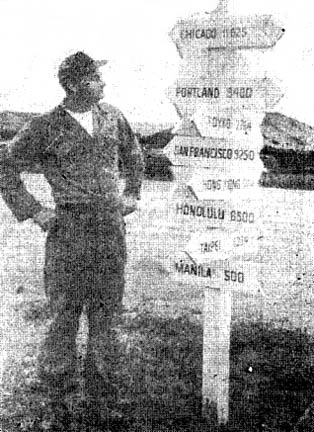 |
TOUGH CHOICE - Where to is now the question puzzling SSgt. Kenneth H. Defer, who came up with idea and built this unique sign post, listing distances to 13 cities around the world. |
How Now, Big Chief, Tell How
Do rain dances really work? The men of the 25th Admin. Co. didn’t think so
until Sp4 Todd C. Darch, 21, of Batavia, N.Y., made them believers.
Specialist Darch, whose great-grandmother was a full-blooded Sioux Indian,
recently volunteered to entertain his friends at a farewell party held in the
Admin. Co. area.
The lights were hastily put out as he prepared to go into his act. Everyone
sat quietly listening in amusement.
“He was chanting just like those Indians you see on the screen,” said PFC
John Dittmann, 22, of Aurora, Il. “I couldn’t help but laugh ... it looked so
funny!”
Actually Pvt.Dittmann was the only one laughing as Specialist Darch raised
his leg up high, cocked his head back and forth and gave out with the familiar
“Eeeoh, eeeoh, eeeah!” of the Sioux tribe.
“He was great! Great!” said Sp4 Edward Rooney, 22, of Chicago, Ill., 15th
P.I. Det. “I never laughed so much.”
Then the laughter stopped as the heavens cracked open with thunder and
lightning and a torrential downpour hit the area.
PFC David Pierce, 23, of Midland Park, N. J., said, “I never saw anything
like it. He had just finished his dance when that storm hit us!”
25th MPs’ Job Hard, Varied
The work being carried out by the 25th MP Co. illustrates why this unit can
be referred to as a multi-mission organization.
Its role encompasses everything from garrison-type police work at Cu Chi to
tactical operations in the field.
The company provides the base camp with a military police desk, motorized
patrols and gate guards on a 24-hour basis. The military policemen at the gates
are especially important, as every vehicle that enters or leaves base camp must
be logged.
Special attention is paid to civilian vehicles; they are thoroughly searched
and the occupants screened.
Each day more than 1000 Vietnamese civilian workers are carefully screened
and searched by the MPs.
On brigade-size combat operations, one of the three MP line platoons is
responsible for providing convoy escorts, VIP security, traffic control, check
points and guards for the brigade prisoner of war (POW) collecting point.
The fourth platoon of the company is responsible for the operation of the
division POW collecting point. This point, which has handled as many as 100
POWs at a time, was constructed by the company.
The security platoon is responsible for the security of the commanding
general, division headquarters and the division tactical operation center.
Guards are provided for these vital areas at night, as well as at other times on
an as-needed basis.
During division operations, the security platoon is able to provide this same
security for the division command post in the field.
A town patrol is operated in the nearby village of Tan An Hoi to provide
security for division troops in the area and to assist the Vietnamese National
Police.
MP teams, in jeeps mounted with machine guns, escort the daily resupply
convoys between Cu Chi and Saigon. Convoys to other areas, including some to
combat areas are also escorted by the company.
The company provides the division Provost Marshal’s office with a five-man
Criminal Investigation Department section. This section conducts all criminal
investigations within the division area and comes directly under the operational
control of the provost marshal.
| TOGETHERNESS - A National Policeman, a Military Policeman of the 25th MP Co., David L. Hausz of Indianapolis, and a Vietnamese QC (military policeman) patrol downtown Cu Chi together. (Photo by Sp5 Robert E. Williams) |
 |
Page 15 TROPIC LIGHTNING NEWS October 1, 1966
US ‘Charlies’ Blank Charlies, 4-0
By Sp4 Bill Becker
When two “Charlies” get together for a contest, the results can be very
one-sided according to the 2nd Battalion, 27th Infantry.
The two “Charlies” who have been involved in quite a few contests, Charlie
Company of the battalion and Viet Cong in the area of Duc Hue and Duc Hoa
Districts near Cu Chi, have paired off three times in the last few weeks.
Co. C, working in conjunction with other battalion units and local Vietnam
Army elements, has come out on top each time, killing a total of 17 VC and
capturing 39 without sustaining a casualty.
To begin their latest encounter about seven miles south of here, the
“Wolfhounds” were airlifted to the area they had visited weeks ago to break up a
VC terrorist ring. The choppers flew to the objective at tree-top level to
prevent VC from detecting them until the last possible moment.
As soon as the first elements of the lift touched down, Charlie Company drew
two rounds of sniper fire. They were the only rounds fired all day.
Accompanied by three VC captured in the previous raid, the company swept
through the area and discovered a cache containing 880 pounds of peanuts, 300
pounds of rice and 100 pounds of tobacco.
After completing their sweep, the company questioned a group of detained
suspects, and one offered to lead them to “five Viet Cong.” With the 1st Squad,
1st Platoon, following close behind, the suspect pointed out a “meeting place.”
As disappointed squad members searched the building and found it empty, one
of the company’s Vietnamese interpreters, who was walking through hedgerows in
the vicinity, called for help.
The Wolfhounds found their interpreter trying to pry open the lid of a spider
hole with his bayonet. Taking positions around the hole, the group talked the
VC inside into lifting the lid and raising slowly with hands held high in the
air.
One Browning Automatic Rifle appeared, then one carbine and four Viet Cong.
The frightened VC, one of whom claimed to be a squad leader, agreed to show the
Wolfhounds more spider holes.
Two more of the hiding places were uncovered, yielding only miscellaneous
medical supplies, blasting caps and rolls of communication wire.
As a result, the Wolfhounds chalked up a 4-0 win and proved again that the
team on its home field doesn’t always have the advantage.
‘Olde Barbour Shoppe’ Finds Ye New Home
“Ye Olde Barbour Shoppe “ of the 125th Sig. Bn. has finally found a permanent
hone after moving for the third time.
The shop, complete with such modern facilities as hot and cold running water,
began on the USNS General John Pope while the ship was transporting the
division’s headquarters elements to South Vietnam.
Sp4 J. Ronald Ham of Red Bank, N.J., and Sp4 Ronald Pogino of Chicago began
cutting hair for the men on the ship. When they arrived at Cu Chi the two found
themselves the “official” barbers for the 125th Sig. Bn,. and immediately began
plans for a shop where they could perform their services.
On April 5 they acquired a small tent kit, and in a few weeks their hard work
developed into a shop.
Soon after, engineers came to build mess halls for the battalion and “Ye Olde
Barbour Shoppe” had to find a new home. With the help of 20 strong bodies the
shop was relocated opposite the battalion’s ball field until the 86th Sig. Bn.
(Support) moved in and the shop was given its second. eviction notice.
Once again specialists Ham and Bogino called for held and the shop was moved
to the vicinity of the battalion theater. It seems like the “Best Clip Joint in
Town” has found a home.
 |
ADDRESS - Maj. Gen. Fred C. Weyand, division commander, addresses officers and men of the division during dedication ceremonies for the Capt. Arthur E. Lewis Dispensary Cu Chi. (Photo by Sp5 Robert Williams) |
25th Dispensary Dedicated To Late Capt. Arthur Lewis
The 25th Med. Bn. base dispensary was recently dedicated to the late Capt.
Arthur E. Lewis during ceremonies held at Cu Chi.
Capt. Lewis, posthumously awarded the Silver Star Medal for heroism, was the
first 25th Medical Corps officer to lose his life in Vietnam.
During the ceremonies Maj. Gen. Fred C. Weyand, division commander, praised
Capt. Lewis for his unassuming humble dedication to duty, his sympathy and
understanding, and the example of heroism he set for all to follow.
On May 17 of this year, the captain-surgeon of the 4th Bn., 23nd Inf., was on
an operation moving through a heavily wooded area with his unit. Capt. Lewis
suddenly heard explosions to his front.
Instantly he rushed forward looking for wounded. While under heavy Viet Cong
sniper fire, he moved into the midst of a mine field and began treating the
wounded soldiers.
As he tried to reach more of the wounded in the mine field, Capt. Lewis was
wounded fatally by a command detonated mine.
Gen. Wayand said that even as the ceremony was taking place, Capt. Lewis’
unit was in that same woods advancing the cause for which he gave his life.
 |
POWER - A 2nd Bn., 27th Inf. soldier carefully looks for a place to plant a Bangalore torpedo as his battalion approaches a treeline with thick underbrush. (Photo by Sp4 Wallace Stachera). |
The Bangalore Torpedo
The Bangalore Torpedo, which looks more like a custom-built pool cue case or
an elongated can of C-rations, as a five-foot long tube of explosive destruction
capable of cutting a hole in the thickest jungle brush.
The tubes are used by the infantry to clear brush, mines and an occasional
Viet Cong.
The torpedoes can he fastened to each other, making one 25-foot torpedo, to
increase the power of the blast. The tubes are set off with electric or
non-electric detonating devices, and can be placed at great distances from the detonator.
The bangalore’s effectiveness is increased by its mobility. It can easily he
carried by an infantryman going into the field. One man can possibly carry two
or three at once, plus his own combat equipment. If the supply in the field
runs out, helicopters can bring in re-supplies.
The bangalore is an effective weapon in the war against the Viet Cong,
destroying, without loss of life many a cleverly booby-trapped treeline.
196th Gets 86 Replacements
The 196th Light Infantry Brigade Replacement Detachment at Tay Ninh opened
for business recently as it received 86 replacements.
Brig. Gen. Edward H. deSaussure Jr., brigade commander, officially welcomed
the men. He said the base camp has shown marked improvement since the brigade’s
arrival.
He also briefed them on some of the activities of the division and the
brigade task force.
In closing, Gen. deSaussure said, “We are glad to have you with us, and I
know you will do well as members of the 196th Brigade Team.”
Another APC Blowup
Few people would like to have an armored personnel carrier (APC) blown from
underneath them once, but 1st Lt. Paul T. Short has had to endure it three times
in the last two months, and he’s had about enough.
On his first operation as platoon leader for the second platoon of Co. B, 1st
Bn. (Mech), 5th Inf., his personnel carrier hit a mine. It blew off the left
track, six road wheels and the suspension system, but almost miraculously, there
were no casualties.
Ten days later, Lt. Short stopped near Truong Mit, about 15 miles northwest
of Cu Chi, for a brief conference on possible mines in the area.
The unit left, arrived at its command post and retraced its steps hack toward
Truong Mit for refueling. Ironically, less than a half hour later, Lt. Short’s
APC hit another mine, at almost the same spot the conference had taken place.
This time the carrier lost only a track and five road wheels. Pieces of
metal were sent flying inside the APC, but again no one was hurt.
During the next five days the lieutenant’s platoon found five mines along the
same road.
Recently, Lt. Short’s track entered the dense jungle, during a sweep north of
the 25th’s base camp when, most annoyingly, another VC mine rocked the ship.
This time losses registered two road wheels and again no casualties.
The Viet Cong are getting worse each time, but Lt. Short would still prefer
they stop.
Page 16 TROPIC LIGHTNING NEWS October 1, 1966
25 Years of Defense
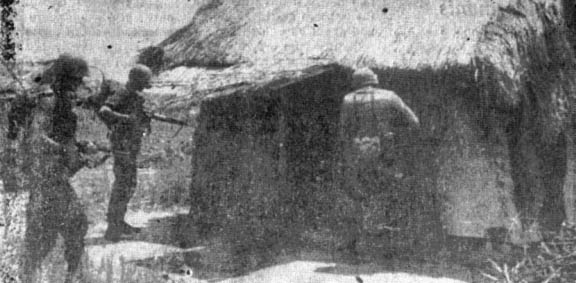 |
| VIETNAM - Three soldiers of the 4th Bn., 23rd Inf., check out a suspected Viet Cong cache near Cu Chi. |
Thanks to:
The 25th Infantry Division Museum for providing the volume of 1966 Tropic
Lightning News,
Ron Leonard, 25th Aviation Battalion for finding and mailing them,
Kirk Ramsey, 2nd Bn., 14th Inf. for creating this page.
This page last modified
01-08-2008
©2008 25th Infantry Division Association. All rights reserved